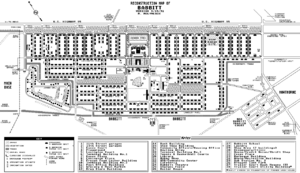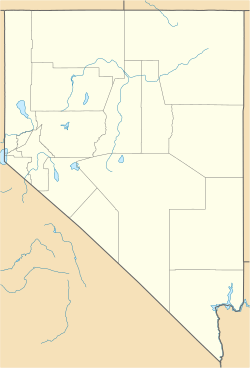Babbitt, Nevada facts for kids
Babbitt was a community in Mineral County, Nevada. It was created in 1941 to provide homes for people working at the nearby Hawthorne Naval Ammunition Depot. This depot was a very important place for storing weapons. Later, during the Cold War, Babbitt was also used as a special radar station. Today, you can still see the old school building and many concrete foundations where buildings once stood. There is also an RV park on the east side of where the community used to be.
Building Babbitt: World War II Homes
Babbitt was the biggest housing project built for workers at the Hawthorne Naval Ammunition Depot during World War II. Many people were needed to work at the depot, so the government had to build homes for them.
- In 1941, the first 25 duplex homes were built. A duplex is like two homes connected together.
- By 1942, 400 more duplexes were added.
- By 1943, there were 487 duplexes.
- Near the end of World War II, Babbitt had about 40 blocks and 584 duplexes.
Most of these duplexes had the same design. Each side of the duplex had four bedrooms, two bathrooms, two kitchens, and two living rooms. Some duplexes were changed to have one, two, or three bedrooms on each side. A few were even turned into single homes with four bedrooms after the war.
The streets in Babbitt had interesting names. Streets that ran east-west were named after famous aircraft carriers, like Essex, Lexington, and Enterprise. The streets running north-south were numbered from 10th to 30th.
Growth During the Korean War
During the Korean War, more homes were built in Babbitt. These new homes were single-family units, not duplexes.
- 65 homes had two bedrooms.
- 35 homes had three bedrooms.
These new homes were built in the western part of Babbitt. Their streets were named after important U.S. Navy figures, like Dahlgren, Jones, Dewey, and Perry. At its busiest around 1954, Babbitt had enough bedrooms for about 2,590 people.
Around this time, some duplexes were moved or removed. One duplex was even moved to a different part of the community to be used as a community center.
A Time of Change: Segregation and Decline
For many years, until the Civil Rights Act of 1964, Babbitt was a segregated community. This meant that people of different races were kept separate. There was a gap of about 150 feet between 26th and 27th streets. This gap separated the area where African American workers and their families lived from the rest of the town.
Some public places were also segregated:
- The movie theater
- The bowling alley
- The soda fountain at Johnson's Pharmacy
The Navy built a small building that became a business called the "BBQ Pit" near the area for African American families. A moved duplex also served as a separate community center for them. Some businesses in town did not allow African American customers. Only one bar, owned by African Americans, served them in the 1950s.
Groups like the NAACP worked to end this separation. They organized protests and demonstrations. Even the state governor tried to help, but it took time. People of all races were not fully integrated into the Babbitt community until 1970.
After the Korean War, fewer people were needed at the depot. Parts of Babbitt started to close down.
- By the early 1960s, 171 duplexes and 51 single homes were gone. Some were sold and moved away.
- From about 1961 to 1985, a Strategic Air Command radar station, called the Hawthorne Bomb Plot, operated within Babbitt.
- By 1970, 114 more duplexes had been moved.
- In the 1970s and 1980s, more sections of Babbitt were closed and taken apart.
The last residents left Babbitt in 1987. Only the school and the bowling alley stayed open for a few more years. In 2004, the Whiskey Flats RV park was built where the radar station used to be.




